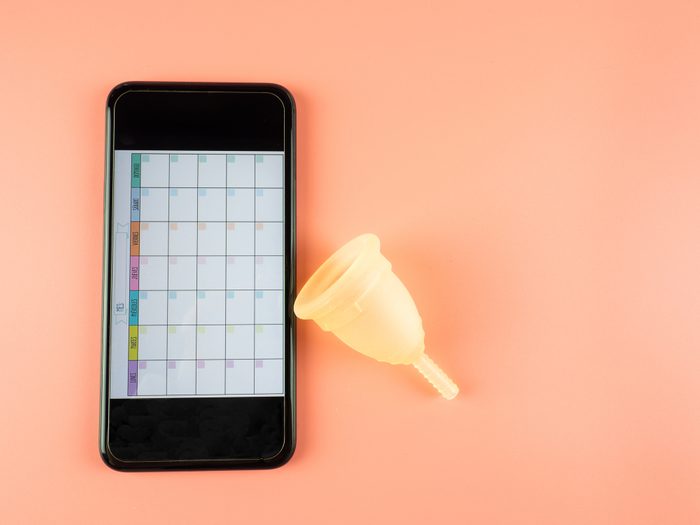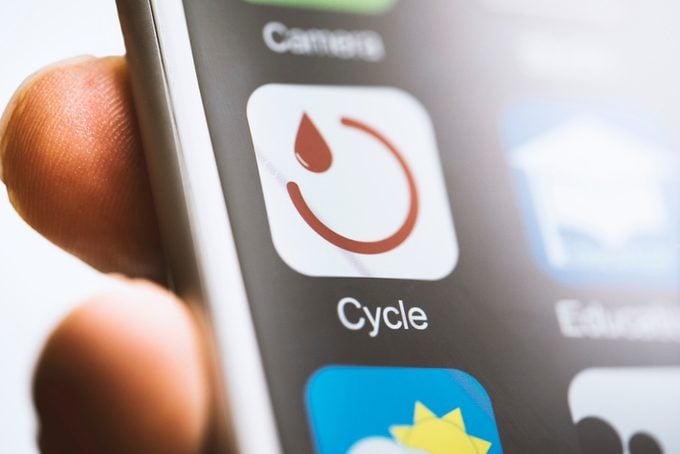What Is Cycle Syncing?
Updated: Feb. 07, 2023

This trendy lifestyle change promises to help you manage the symptoms of PMS—but is it legit?
Anyone who has ever experienced a menstrual cycle knows it can be a real pain. From brain fog and back aches to restless sleep and intense cravings, the symptoms of premenstrual syndrome (PMS) can be wildly disruptive to a person’s daily life.
Naturally, many of us are looking for ways to lessen the negative impact of our cycles, including making changes to our diet and exercise routines. And when searching for these solutions, one trendy buzzword keeps coming up these days: cycle syncing. But what is cycle syncing and is it scientifically backed? To answer all your questions, we collated the most recent information.
What Is Cycle Syncing?
According to Healthline, the term “cycle syncing” was coined by Alisa Vitti, Functional Nutritionist, HHC, AADP. In short, it describes the process of aligning your diet and exercise routine to the different phases of your menstrual cycle. The foundational concept is that by tailoring your lifestyle to your cycle, you are better able to meet the hormonal needs of your body.
What Are the Purported Benefits of Cycle Syncing?
Proponents of cycle syncing claim that it allows you to “[work] with your body and not against it.” This translates to possibly feeling “more productive [and] energized” and “experienc[ing] fewer period symptoms.” In an interview with the New York Times, Vitti claimed that her own practice of cycle syncing aligned with her relief from symptoms of polycystic ovarian syndrome (PCOS), a health condition that affects as many as 5 million U.S. women of reproductive age.
Is Cycle Syncing Effective?
First and foremost, there is not sufficient scientific research to explicitly support cycle syncing. Many supporters of cycle syncing run blogs—they are not doctors, as Vice journalist Hannah Smothers points out. Additionally, neither Planned Parenthood nor the American College of Obstetricians and Gynecologists has published anything on the topic. Notably, the article in the Times makes a distinction between “wellness” and “health,” filing the interview under “self care,” as opposed to anything scientifically authoritative.
All of this said, it’s easy to understand how health businesses have distorted or reduced the scientific knowledge we do have. Notably, numerous studies show time and again that the hormone levels at different phases of a menstrual cycle have some correlation with the efficacy of different workouts.
For example, during the luteal phase, when estrogen and progesterone are at their highest, people experience noticeable increases in strength and endurance. They can feel more energized and burn calories more easily. Additionally, they may experience the greatest change in muscle mass. All of this data could suggest that the luteal phase is optimal for strength training.
On the other hand, during the menstrual phase (your actual period), estrogen and progesterone are at their lowest. You are likely to feel fatigued and may not see significant changes in muscle mass. As such, this phase may be best suited to lower-intensity workouts, such as yoga, that allow your body to recover.
Still, we also know that menstrual cycles are deeply individual. While a “traditional” cycle is slated at 28 days, cycle lengths can vary by up to 14 days. Additionally, hormone levels are different from person to person, and vary widely even within one cycle phase. Therefore, matching exercise and diet to hormonal levels based solely on phases is a highly imperfect—and, again, not scientifically backed—practice.
How Can I Try Cycle Syncing?

The good news here is that as long as you are prioritizing some basic health principles and listening to your body, cycle syncing is unlikely to cause you any harm. So, if after all those disclaimers, you’d still like to give it a try, here’s how you can do so healthily.
How can I track my cycle?
The first step to cycle syncing is to understand the timing of your cycle. To do so, you can try an app like Glow, Clue, Kindara, Flo or Spot On. Be mindful of how these apps may be tracking your data, and know that it may take up to three months to get a solid understanding of the timing of your phases.
What should I eat?
Forbes Health spoke to Tracy Lockwood Beckerman, a registered dietician and author of The Better Period Food Solution to answer this question. In general, try to avoid alcohol, processed foods and foods high in sugar, opting instead for whole foods. Beckerman’s more specific nutritional suggestions are listed below.
Menstrual Phase
Keep up your iron levels with nuts, lentils and meat. Additionally, “eat foods that help reduce inflammation and replenish blood loss like omega-3s (eggs and walnuts) and vitamin B12 (fortified cereals, alternative milks).”
Follicular Phase
Prioritize high-fiber foods, fermented foods and foods high in zinc, such as eggs and whole grains.
Ovulatory Phase
“[C]hoose high-quality nutrition over high quantity nutrition,” says Beckerman. Additionally, “opt for fiber-rich foods like quinoa, berries and couscous.”
Luteal Phase
To help rebuild your uterine lining, choose foods with heart-healthy fats like walnuts and avocados, as well as slow-digesting carbohydrates like sweet potatoes and beans.
How should I work out?
Beckerman’s suggestions for exercise at different menstrual phases can be found below. Funnily enough, you may find that you are following some of these guidelines naturally, such as resting during your period.
Menstrual Phase
If you’re feeling fatigued, now is a great time to rest up, focusing on a gentler exercise like walking, stretching or yoga.
Follicular Phase
According to Beckerman, “This is a good time to do a zumba or cardio workout,” as estrogen levels and energy levels are on the rise.
Ovulatory Phase
Boosted hormone levels often leave menstruators feeling strong during this phase. Beckerman says, “You will get more power into your workouts, so engage in exercises that support this, like a dance class, HIIT or Crossfit.”
Luteal Phase
“You may start to feel more anxious and more tired because your hormones start to plummet,” Beckerman notes. “Rechannel this into more centered and spiritual exercise like yoga, pilates or even meditation.”
The bottom line
As with many of these buzzy health fads, cycle syncing is not a miracle cure for PMS, PCOS or anything else. But eating more whole foods and getting more exercise is rarely a bad thing, so if cycle syncing helps motivate you to do so, go for it. Just also make sure you are talking regularly to a trusted doctor about any particular health concerns, not just relying on internet “self-care” brands or blogs for advice.
Get The Healthy @Reader’s Digest newsletter and follow The Healthy on Facebook, Instagram, and Twitter. Keep reading:

















